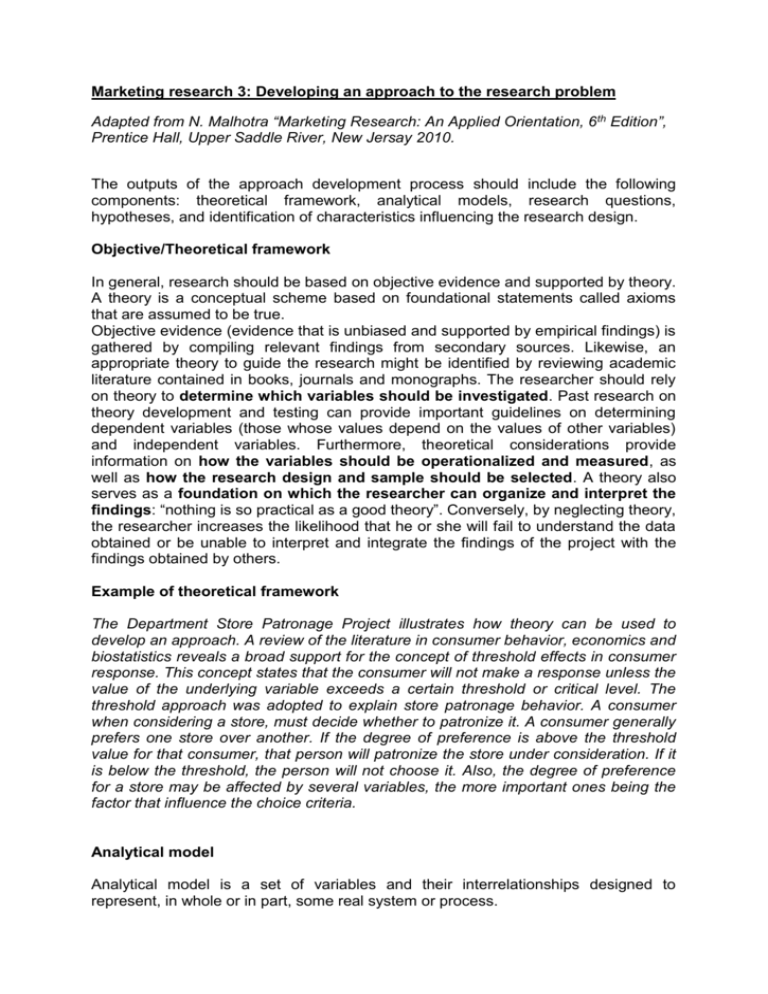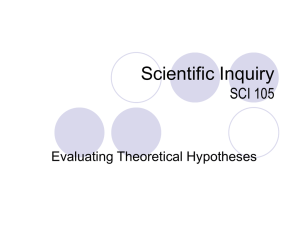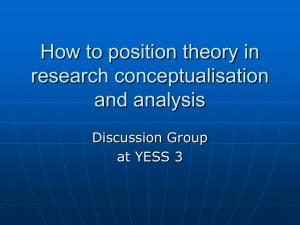Marketing research 3
advertisement

Marketing research 3: Developing an approach to the research problem Adapted from N. Malhotra “Marketing Research: An Applied Orientation, 6 th Edition”, Prentice Hall, Upper Saddle River, New Jersay 2010. The outputs of the approach development process should include the following components: theoretical framework, analytical models, research questions, hypotheses, and identification of characteristics influencing the research design. Objective/Theoretical framework In general, research should be based on objective evidence and supported by theory. A theory is a conceptual scheme based on foundational statements called axioms that are assumed to be true. Objective evidence (evidence that is unbiased and supported by empirical findings) is gathered by compiling relevant findings from secondary sources. Likewise, an appropriate theory to guide the research might be identified by reviewing academic literature contained in books, journals and monographs. The researcher should rely on theory to determine which variables should be investigated. Past research on theory development and testing can provide important guidelines on determining dependent variables (those whose values depend on the values of other variables) and independent variables. Furthermore, theoretical considerations provide information on how the variables should be operationalized and measured, as well as how the research design and sample should be selected. A theory also serves as a foundation on which the researcher can organize and interpret the findings: “nothing is so practical as a good theory”. Conversely, by neglecting theory, the researcher increases the likelihood that he or she will fail to understand the data obtained or be unable to interpret and integrate the findings of the project with the findings obtained by others. Example of theoretical framework The Department Store Patronage Project illustrates how theory can be used to develop an approach. A review of the literature in consumer behavior, economics and biostatistics reveals a broad support for the concept of threshold effects in consumer response. This concept states that the consumer will not make a response unless the value of the underlying variable exceeds a certain threshold or critical level. The threshold approach was adopted to explain store patronage behavior. A consumer when considering a store, must decide whether to patronize it. A consumer generally prefers one store over another. If the degree of preference is above the threshold value for that consumer, that person will patronize the store under consideration. If it is below the threshold, the person will not choose it. Also, the degree of preference for a store may be affected by several variables, the more important ones being the factor that influence the choice criteria. Analytical model Analytical model is a set of variables and their interrelationships designed to represent, in whole or in part, some real system or process. Models can have many different forms. The most common are verbal, graphical, and mathematical structures. In verbal models, the variables and their relationships are stated in prose form. Such models may be mere restatements of the main tenets of the theory. Graphical models are visual. They are used to isolate variables and to suggest directions of relationships but are not designed to provide numerical results. They are logical preliminary steps to developing mathematical models. Mathematical models explicitly specify the relationships among variables, usually in equation form. These models can be used as guides for formulating the research design and have the advantage of being amenable to manipulation. Examples of various models Verbal model A consumer first becomes aware of a department store. That person then gains an understanding of the store by evaluating the store in terms of the factors comprising the choice criteria. Based on the evaluation, the consumer forms a degree of preference for the store. If preference exceeds a certain threshold level, the consumer will patronize the store. Graphical model Patronage Preference Understanding Awareness Mathematical model y=a0+Σaixi where y – degree of preference a0, ai – model parameters to be estimated statistically xi – store patronage factors that constitute the choice criteria As can be seen from this example, the verbal, graphical, and mathematical models depict the same phenomenon or theoretical framework in different ways. The phenomenon of threshold effect stated verbally is represented for clarity through a figure and is put in equation for ease of statistical estimation and testing. The verbal, graphical and mathematical models complement each other and help the researcher identify relevant research questions and hypotheses. Research questions Research questions are refined statements of the specific components of the problem. Each component of the problem may have to be broken down into subcomponents or research questions. Research questions ask what specific information is required with respect to the problem component. If the research questions are answered by the research, then the information obtained should aid the decision maker. The formulation of the research questions should be guided not only by the problem definition, but also by the theoretical framework and the analytical model adopted. For a given problem component, there are likely to be several research questions. The research questions are further refined by precisely defining the variables and determining how they were to be operationalized. Hypotheses A hypothesis is an unproven statement or proposition about a factor or phenomenon that is of interest to the researcher. It may, for example, be a tentative statement about relationships between two or more variables as stipulated by the theoretical framework or the analytical model. Often, a hypothesis is a possible answer to the research question. Hypotheses go beyond research questions because they are statements of relationships or propositions rather then merely questions to which answers are sought. Research questions are interrogative, hypotheses are declarative and can be tested empirically. An important role of a hypothesis is to suggest variables to be included in the research design. The relationship between the marketing research problem, research questions, and hypotheses, along with the influence of the theoretical framework and analytical models is described below in the figure. Components of the marketing research problem Theoretical framework Research questions Analytical model Hypotheses









